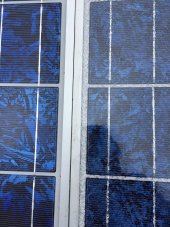I recently purchased some used panels, only $40 a piece, as they were cracked.
I have 24V EVE 280ah battery bank, and an MPP HV LV 2424, the green one.
I have bulk and float at 27.8v. I have an OverKill Solar 80A 8S BMS.
I tested the cells when purchasing them and they were putting out the same volts as the uncracked cells. At home I tested the cells on an AMP meter and got close to 9A on short. My battery is currently at 80AH / 280 AH, and I top balanced the cells when I first got them.
I'm currently only getting 300 watts with 2 cells in series with the sun out and bright. It's almost May in North Carolina. I had the panels completely flat when the sun was out at it's highest.
Are the panels likely defective? Is there some way to check? I'm in the process of figuring out optimal placement. Unbroken panels were $135 a piece so even at half power I suppose it works out but I want to be able to tell. I'm planning on using some UV sealant on the cells that were badly cracked. I'm currently testing the cells without any sealant.
| Model: Q.Plus-L-G4.2 - 335 W |
| Electrical Watts: (STC) 335 W Max Power |
| Voltage: (VMPP) 37.33 V |
| Max Power Current: (IMPP) 8.97 A |
| Open Circuit Voltage: (VOC) 46.81 V |
| Short Circuit Current: (ISC) 9.54 A |
| Max System Voltage: (UL) DC 1500 V |
I have 24V EVE 280ah battery bank, and an MPP HV LV 2424, the green one.
I have bulk and float at 27.8v. I have an OverKill Solar 80A 8S BMS.
I tested the cells when purchasing them and they were putting out the same volts as the uncracked cells. At home I tested the cells on an AMP meter and got close to 9A on short. My battery is currently at 80AH / 280 AH, and I top balanced the cells when I first got them.
I'm currently only getting 300 watts with 2 cells in series with the sun out and bright. It's almost May in North Carolina. I had the panels completely flat when the sun was out at it's highest.
Are the panels likely defective? Is there some way to check? I'm in the process of figuring out optimal placement. Unbroken panels were $135 a piece so even at half power I suppose it works out but I want to be able to tell. I'm planning on using some UV sealant on the cells that were badly cracked. I'm currently testing the cells without any sealant.



